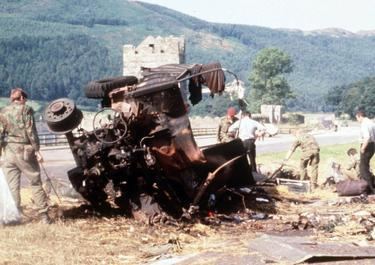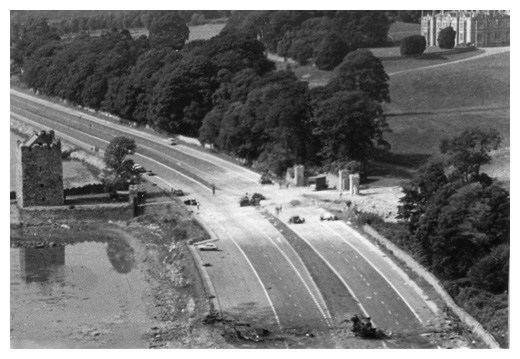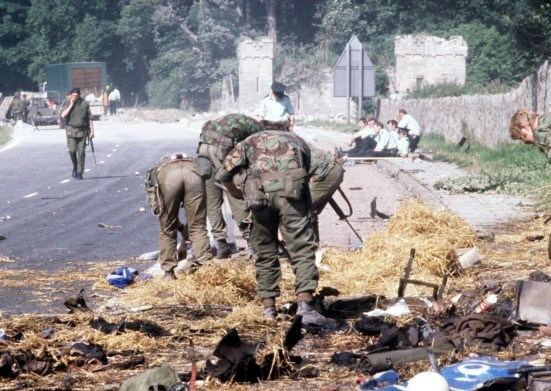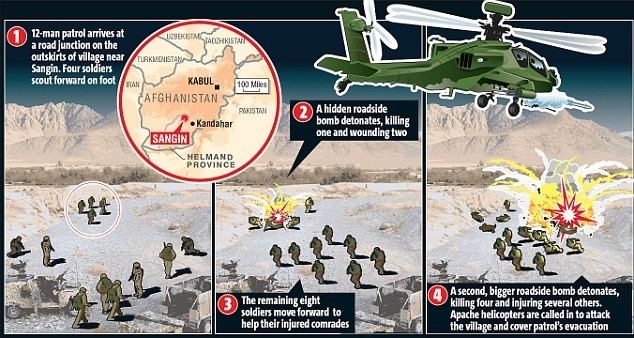None 18 killed6 wounded | Date 27 August 1979 | |
 | ||
Joe BrennanBrendan Burns Lieutenant ColonelDavid Blair † Similar Drummuckavall Ambush, Attack on Derryard checkpoint, Clonoe ambush | ||
Warrenpoint ambush
The Warrenpoint ambush or Narrow Water ambush (also called the Warrenpoint massacre or Narrow Water massacre) was a guerrilla attack by the Provisional Irish Republican Army (IRA) on 27 August 1979. The IRA's South Armagh Brigade ambushed the British Army with two large roadside bombs at Narrow Water Castle (near Warrenpoint) in Northern Ireland. The first bomb was aimed at a British Army convoy and the second targeted the reinforcements sent to deal with the incident. IRA volunteers hidden in nearby woodland also allegedly fired on the troops. The castle is on the banks of the Newry River, which marks the border between Northern Ireland and the Republic of Ireland.
Contents

Eighteen British soldiers were killed and six were seriously injured, making it the deadliest attack on the British Army during the Troubles. An English civilian was also killed and another injured when British soldiers fired across the border after the first blast. The attack happened on the same day that the IRA assassinated Lord Louis Mountbatten.

First explosion

At 16:40, a British Army convoy consisting of one Land Rover and two four-ton lorries was driving past Narrow Water Castle on the A2 road. As it passed, a 500-pound (227 kg) fertiliser bomb, hidden in a lorry loaded with strawbales and parked near the castle, was detonated by remote control. The explosion caught the last lorry in the convoy, hurling it on its side and instantly killing six members of 2nd Battalion, The Parachute Regiment, whose bodies were scattered across the road. There were only two survivors amongst the soldiers travelling in the lorry; they both received serious injuries. Anthony Wood (19), the lorry's driver, was one of those killed. All that remained of Wood's body was his pelvis, which had been welded to the seat by the fierce heat of the blast.

Immediately after the blast, the soldiers said they were targeted by sniper fire, coming from woods on the other side of the border. The soldiers began firing back across the water. An uninvolved civilian Englishman, Michael Hudson, was killed by the soldiers' gunfire and his cousin Barry Hudson wounded. They had been birdwatching on an island opposite the castle. According to Royal Ulster Constabulary (RUC) researchers, the soldiers may have mistaken the sound of ammunition going off for enemy gunfire. However, two IRA members arrested by the Gardaí and suspected of being behind the ambush, Brendan Burns and Joe Brennan, had traces of gunsmoke residue on their hands and the motorbike they were riding on.

On hearing the first explosion a Royal Marine unit alerted the British Army and reinforcements from other units of the Parachute Regiment were dispatched to the scene by road. A rapid reaction unit, consisting of medical staff and senior commander Lieutenant-Colonel David Blair (the commanding officer of the Queen's Own Highlanders), together with his signaller Lance Corporal Victor MacLeod, were sent by Gazelle helicopter; another helicopter, a Wessex, landed to pick up the wounded. Colonel Blair assumed command once at the site.
Shooting of Hudson cousins
William (Bill) Hudson, a 29-year-old from London, was shot dead by the British army and his cousin Barry Hudson, a native of Dingle, was wounded by shots which were fired across Carlingford Lough into Omeath, Co Louth.
The pair were partners in 'Hudson Amusements' and had been operating their amusements in Omeath for the duration of the Omeath Gala. When the first explosion was heard across the Lough, the pair went down to the shore to see what was happening. The pair made their way to Narrow Water on the southern side to get a better view of what was happening on the northern side of the Lough. Barry Hudson was shot in the arm and as he fell to the ground he saw his cousin, who was the son of a coachman at Buckingham Palace, fall to the ground. He died almost immediately.
Second explosion
The IRA had been studying how the British Army behaved after a bombing and correctly predicted that they would set up an incident command point (ICP) in the gatehouse on the opposite side of the road. At 17:12, thirty-two minutes after the first explosion, an 800-pound (363 kg) bomb hidden in milk pails exploded against the gatehouse, destroying it and hurling lumps of granite through the air. It detonated as the Wessex helicopter was taking off carrying wounded soldiers. The helicopter was damaged by the blast but did not crash.
The second explosion killed twelve soldiers: ten from the Parachute Regiment and the two from the Queen's Own Highlanders. Mike Jackson, then a Major in the Parachute Regiment, was at the scene soon after the second explosion and later described seeing body parts scattered over the road, in the water and hanging from the trees. He was asked to identify the face of his friend, Major Peter Fursman, still recognisable after it had been completely ripped from his head by the explosion and recovered from the water by divers from the Royal Engineers. Only one of Colonel Blair's epaulettes remained to identify him as his body had been vaporised in the blast. The epaulette was taken from the scene by Brigadier David Thorne to a security briefing with Prime Minister Margaret Thatcher to "illustrate the human factor" of the attack.
Press photographer Peter Molloy, who arrived at the scene after the first explosion, came close to being shot by an angry paratrooper who saw him taking photographs of the dead and dying, instead of offering to help the wounded. The soldier was tackled by his comrades. Molloy said, "I was shouted at and called all sorts of things but I understood why. I had trespassed on the worst day of these fellas' lives and taken pictures of it."
Aftermath
The Warrenpoint ambush was a propaganda victory for the IRA. It was the deadliest attack on the British Army during The Troubles and the Parachute Regiment's biggest loss since World War II. The 2nd battalion of the British Parachute regiment sustained sixteen casualties. The first battalion of the Parachute Regiment was responsible for Bloody Sunday on 30 January 1972 where 14 unarmed protesters were shot dead. The IRA made clear it was targeting British paratroopers because of Bloody Sunday. General Sir James Glover, Commander of British forces in Northern Ireland, said it was "arguably the most successful and certainly one of the best planned IRA attacks of the whole campaign".
The ambush happened on the same day that Lord Louis Mountbatten, a prominent member of the British Royal Family, was killed by an IRA bomb aboard his boat at Mullaghmore, along with three others.
Shortly after the Warrenpoint ambush, IRA members Brendan Burns and Joe Brennan were arrested by Gardaí (the Irish police). They were stopped while riding a motorbike on a road opposite Narrow Water Castle. However, they were later released on bail due to lack of evidence.
Immediately after the Mountbatten and Warrenpoint attacks, the Ulster Volunteer Force (UVF) retaliated by shooting dead a Catholic man, John Patrick Hardy (43), at his home in Belfast's New Lodge estate. Hardy was targeted in the mistaken belief that he was an IRA member.
According to Toby Harnden, the attack "drove a wedge" between the Army and the RUC. Lieutenant-General Sir Timothy Creasey, General Officer Commanding Northern Ireland, suggested to Margaret Thatcher that internment should be brought back and that liaison with the Gardaí should be left in the hands of the military. Sir Kenneth Newman, the RUC Chief Constable, claimed instead that the British Army practice, already in place since 1975, of supplying their garrisons in South County Armagh by helicopter, gave too much freedom of movement to the IRA. One tangible security outcome was the appointment of Sir Maurice Oldfield to a new position of Co-ordinator of Security Intelligence in Northern Ireland. His role was to co-ordinate intelligence between the military, MI5 and the RUC. The other was the expansion of the RUC by 1,000 members. Tim Pat Coogan asserts that ultimately, the death of these 18 soldiers hastened the move to Ulsterisation.
Lieutenant-Colonel Blair is remembered on a memorial at Radley School.
IRA member Brendan Burns was killed in 1988 when a bomb he was transporting exploded prematurely. IRA member Joe Brennan, from South Armagh, was jailed in 1996 on explosives charges not related to Warrenpoint. He was released under the Good Friday Agreement.
